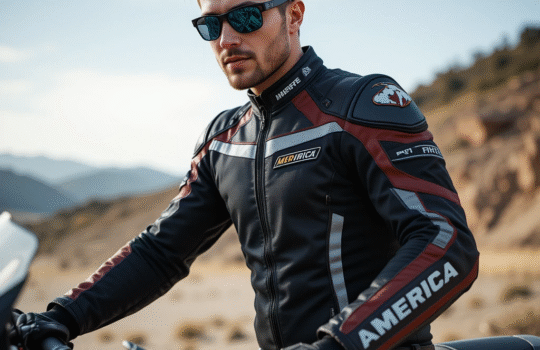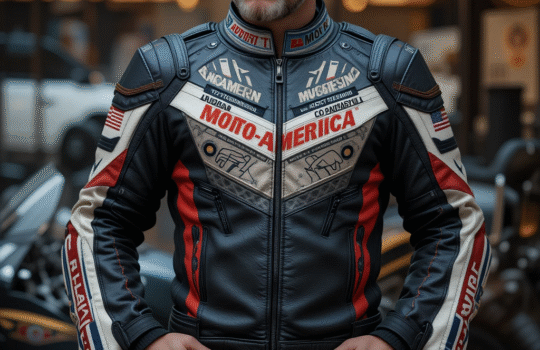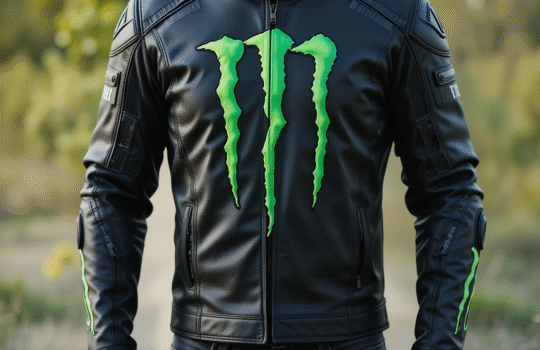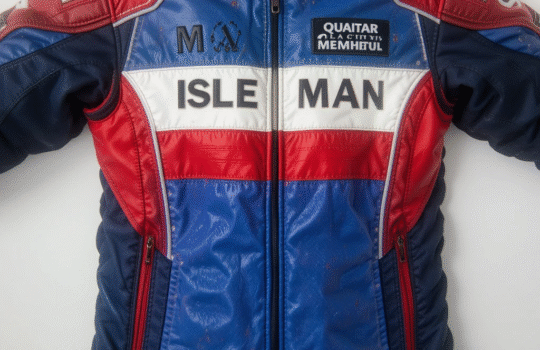Racing Motorcycle Suit: Why It’s Essential for Every Rider
Introduction
Motorcycling, especially racing, is exhilarating. The speed, the thrill, and the adrenaline rush are unmatched. However, as exciting as racing can be, it is also risky. This is why every professional racer or enthusiast needs a racing motorcycle suit. Not just for protection, but to boost performance and comfort on the track. But what exactly makes a racing suit so crucial, and what should you look for when purchasing one? Let’s dive into it.

What is a Racing Motorcycle Suit?
A racing motorcycle suit is specialized protective gear designed for riders engaging in high-speed racing activities. This suit covers the rider’s body, including essential areas like the back, elbows, knees, and shoulders, offering protection against road rash, abrasions, and potential injuries during a fall or crash. Unlike casual riding gear, racing suits are crafted with enhanced safety features and materials that can withstand the intense demands of a race.
Why Do You Need a Racing Suit?
When you’re racing, you’re not just riding a motorcycle; you’re pushing the limits of speed, agility, and control. Every second counts. Racing suits are built to protect you while you achieve that thrill.
Think of it this way: Just like an astronaut needs a space suit to survive the harsh environment of space, a racer needs a motorcycle suit to survive the harsh realities of the track. Without a racing suit, a rider is exposed to higher risks from falls, collisions, and abrasions.
Key Features of a Racing Motorcycle Suit
When it comes to racing suits, it’s not just about looking cool; several key features set them apart from regular riding jackets and pants:
- Armour and Padding: Racing suits are equipped with strategically placed armour to protect high-risk areas.
- Aerodynamic Design: They are designed to be aerodynamic, reducing drag and enhancing speed.
- Ventilation: Despite being protective, they often include vents for air circulation to keep the rider cool.
- Durability: Racing suits are built to last, made from tough materials like leather or advanced textiles that can endure the abrasiveness of high-speed racing.
Material Used in Racing Suits
When it comes to the material, racing suits are typically made from two main materials: leather and textile.
- Leather is the traditional choice and is popular for its abrasion resistance and durability. It molds to the body over time, offering a perfect fit.
- Textile suits are lighter and often include advanced materials like Cordura or Kevlar, which offer great flexibility and comfort while still being protective.
Both types of materials have their pros and cons, but each provides the essential protection needed for racing.
Safety Standards for Racing Suits
Safety is paramount when it comes to racing. Racing suits adhere to strict international safety standards, ensuring that they can withstand high speeds and protect against potential impacts. Look for suits that are approved by organizations like CE, FIM, or ISO.
- CE Approval: This certification ensures that the suit meets the European Union’s rigorous safety standards for motorcycle clothing.
- FIM: The Federation Internationale de Motocyclisme sets regulations for racing suits used in professional races.
How to Choose the Right Racing Suit?
Choosing the right racing suit isn’t a one-size-fits-all scenario. Here’s what to consider:
- Size: Make sure the suit fits snugly. It shouldn’t be too tight or too loose.
- Comfort: Look for suits with strategically placed stretch panels and breathable materials.
- Protection: Ensure that the suit has ample padding in critical areas (like knees, elbows, and back).
- Flexibility: Opt for suits with ample joint mobility for comfortable movement.
- Brand Reputation: Go for well-known brands that specialize in racing gear, such as Alpinestars, Dainese, and Spidi.
Different Types of Racing Motorcycle Suits
Racing suits come in different configurations based on the level of racing and the rider’s needs. Some common types include:
- One-Piece Suits: These are the most common and provide the best protection, as they cover the whole body without any gaps.
- Two-Piece Suits: These suits offer more flexibility, allowing you to remove the jacket or pants as needed, but they might offer slightly less protection than one-piece suits.
- Custom Suits: For serious racers, custom suits are designed specifically to their body measurements and requirements.
The Role of Padding and Armor in Racing Suits
Padding and armor are crucial components of a racing suit. They are designed to absorb impact and protect vital areas of the body in the event of a crash. Common areas that are padded or armored include:
- Shoulders
- Elbows
- Knees
- Back
The armor used in racing suits is often made of materials like foam, hard plastic, or carbon fibre to offer maximum protection without compromising flexibility.

How to Maintain Your Racing Suit
Maintaining your racing suit is essential to ensure its longevity and safety. Follow these simple steps:
- Clean Regularly: Keep your suit clean by wiping it down with a damp cloth after each race. Leather suits can be cleaned using specialized leather cleaners.
- Store Properly: Store your suit in a cool, dry place. For leather suits, make sure they are not exposed to direct sunlight for long periods.
- Repairs: If your suit is damaged, have it repaired by a professional to maintain its protective capabilities.
Do Racing Suits Improve Performance?
Yes! Racing suits not only protect but also enhance a rider’s performance. The streamlined design helps reduce drag, while the suit’s flexibility allows riders to move more freely, improving comfort during high-speed racing. Additionally, the armor ensures that a rider is not distracted by discomfort or fear of injury, allowing them to focus entirely on the race.
Racing Suit Design and Comfort
While safety is the priority, comfort should not be overlooked. Modern racing suits are designed to provide maximum comfort by integrating materials that wick away moisture, maintain breathability, and fit ergonomically to the rider’s body. Many suits also come with adjustable features, like straps or stretch panels, to help ensure the best possible fit.
Choosing Between Leather vs Textile Suits
The choice between leather and textile comes down to personal preference and the type of racing you’re doing.
- Leather suits are heavy-duty, offering excellent abrasion resistance. They’re great for track racing, where protection is paramount.
- Textile suits are lighter, often more breathable, and tend to be more affordable. These are great for road racing or if you’re looking for comfort and flexibility.
The Importance of Fit in a Racing Suit
The fit of your racing suit can make or break your race. A poorly fitting suit can lead to discomfort, restricted movement, and even injury. The suit should be snug but not restrictive, allowing you to move freely while maintaining adequate protection.
Racing Suit vs Regular Motorcycle Gear
What’s the difference between a racing suit and regular motorcycle gear? Regular gear works for everyday riding and provides basic protection. In contrast, A racing suit handles high-speed, high-risk situations with advanced protection and performance-focused design. It offers superior protection, higher-quality materials, and a design focused on performance and safety.
Conclusion: Is a Racing Suit Worth the Investment?
Absolutely! Whether you’re a professional racer or just enjoy hitting the track on weekends, investing in a racing motorcycle suit is essential for your safety and performance. It offers crucial protection and enhances comfort and confidence, allowing you to focus on the race, not your gear.
FAQs
1. Do I need a racing motorcycle suit for track riding?
Yes, a racing suit provides the necessary protection from falls and abrasions, reducing the risk of serious injury.
2. Can I use a regular motorcycle jacket for racing?
Regular jackets don’t handle the extreme demands of racing, but a racing suit offers the protection and performance needed for higher speeds.
3. How do I know if my racing suit fits correctly?
The suit should feel snug but not restrictive. You should be able to move
Read more: Motorcycle Racing Suit: Ultimate Guide for Riders | Safety & Performance





